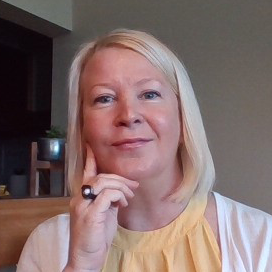In the 1960s, people were fascinated by the idea that someday paper might be replaced by computers. Fast forward 50 years, and now people wonder why paper is still hanging around in the digital-first age.
And paper is inefficient and reduces productivity—on average employees spend four hours a week completing paper-related tasks. It’s also costly; companies with 1,000 employees typically spend 3.5 million dollars a year on paper and paper-related tasks. There’s also the environmental toll (the power it takes to make paper is significant and the ink cartridges often end up in landfills). All of which makes going paperless more attractive than ever. But how do you do it?
Heather Johnson, compliance officer for A-B Emblem, the maker of emblems, patches, and insignia for companies around the world, shared her experience of how Kintone helped her company make the digital move. And it was quite a feat for a company “rich in tradition and set in their ways.”
Going paperless isn’t just possible, it can be simple
Heather’s Kintone story started when a co-worker approached her with a workflow problem that couldn’t be solved with their “faux-digital” process—taking a manual, paper-based process and simply copying it into a digital format without reviewing it first to make sure all the steps work and make changes where they don’t. Frustrated, Heather began searching for a software solution that would replace their outdated faux process for good.
And it didn’t take long before she discovered Kintone and signed up for a free trial. In just a couple of days, she was able to build a solution that allowed her co-worker to accomplish in three minutes what had previously taken her three days to do. And, overall, Kintone helped reduce A-B Emblem’s overhead by 50%—initiated and managed by someone who had never heard of no-code/low code software.
“One thing that really stands out to me is that anyone can use it. A lot of software is only great if you’re a programmer and have the specialized experience, but Kintone is open to anyone. No matter what kind of user you are or what your programming experience is, you can make something from it.”
The ease of making the digital transformation debunked a bunch of myths she believes holds other companies back from doing the same.
Heather called out these going-paperless myths in the webinar:
- Digital transformation can be achieved by small-medium sized businesses
- There are cost-effective tools out there
- It’s not as scary or as hard as everyone thinks
- Your data is still safe
- It doesn’t take a full-blown IT department
- It won’t take years, more like days
- You don’t have to be a programmer to build your own apps
Best practices for leaving paper behind
While Heather found the right software she needed to get A-B Emblem’s digital ball rolling, there were many steps involved to make a successful conversion. To help other companies ditch paper, Heather gathered tips that will likely apply to any business.
Get leadership buy-in.
In order to get the green light from the people at the top of your organization, a must for a strong digital push, you’ll want to show them the value and specific benefits of making the digital investment—and why the solution you’ve found is the right choice.
Heather was able to demonstrate that going with Kintone meant having a solution with:
- Enhanced analytics
- Better (and faster) communications
- Speedier problem solving and mitigation
- Increased cost effectiveness
- Lower risk
- Minimal to no downtime during development and implementation
- Faster overall processing
- More answers to various types of problems
- Scalability
How valuable each benefit will be for your company depends on your company’s needs. For A-B Emblem, more efficient problem solving and mitigation was the benefit they’ve had the most success with and what catapulted the company into having a full-blown digital transformation.
Onboard the team.
For Heather, getting her team started with Kintone was her favorite part of the switch because this is where it operates the most, and her co-workers understand better than anyone else in the company, even management, that it’s a better system than what they had before.
But, to get your team excited and ready to go, Heather says you should:
- Make it personal to them and their job/tasks and how it’s going to benefit them on a daily basis
- Demonstrate and explain how it will make things faster, more productive, and more efficient for them
- Keep them involved (get their ideas and use them!)
- Take the time to break things down and get their input on what they think would make a process better
- Explain the benefits of digital over paper at the task level (go beyond the jargon)
- Look for ways to reduce redundancy, duplicate steps, and minimize data entry
Make sure you’re creating a better workflow.
Now that you’ve got the tool you need to make a digital transformation (and say goodbye to paper), Heather has some advice about really using it wisely to get the most out of the software as possible. That should add up to better workflows and Heather recommends bringing in people who are totally unfamiliar with your process for a fresh perspective.
Other ways to ensure you’re creating better workflows include:
- Don’t lock yourself in to just trying to “fix” a process—be willing to “can” it completely when you can see it’s not working or doesn’t really lead to a digital transformation
- Keep a close watch on repeated steps of any kind at any point in the process
- Count your clicks and decide where you can reduce the number
- Determine how many times the same data has been entered (this is usually a good place to automate the process)
- Look for over-compensating and “hidden” processes that employees (and managers) create as part of their workflow
- Benchmark and analyze—figure out where you are now and then lay out a map for where you want to go next
Work in phases for the win!
While there is no cookie-cutter guide to going paperless, there are some good rules and patterns you can follow, including knowing your management and employee’s style and personality. Heather found that it was effective to break it out into four distinct phases.
Phase one: Gather your data and analyze it
- Pick a process to start with
- Evaluate the process objectively
- Look for over-compensating unofficial steps
- Get feedback from process owners and operators
- Track information (from time and steps to approvals and verifications)
Phase two: Map out both the current and desired processes
- Try value-stream mapping that uses the current process to help design the future process
- Start with mapping the current phase and Include all the individual steps
- Move on to the desired process doing the same
Phase three: Start developing feedback (develop, test, feedback, repeat)
- Gather feedback from upper management on the division level
- Gather feedback from middle management on the department level
- Gather feedback from employees on the process level
Phase four: Train, implement, feedback, development, repeat
- Train employees
- Set “go live” dates for hard deadlines
- Modular rollout by department, teams, and categories
- Have a plan for once the process is live to follow up, get feedback, continue to train, celebrate accomplishments and determine what processes to make digital next time
If they can go paperless, so can you
A digital transformation doesn’t have to be overwhelming. With Heather’s advice and Kintone’s technology, you can be confident that your company is ready to go paperless. And once you do, there’s a good chance you’ll wonder why your company, like A-B Emblem, was holding to a tradition that wasn’t helping their organizational efficiency or their bottom line.
About the Author
Kristy is a writer living in Atlanta, Georgia where she works, plays and explores life. When it comes to writing, she’s pretty much dabbled in nearly every form—she penned her first published piece, a poem titled “What’s in a Name,” when she was in grade school—she finds it ironic that she has forgotten peoples’ names all her life. When she isn’t moving her fingers on a keyboard, she’s likely enjoying time with friends, playing tennis or spoiling her 10-year-old Scottish Fold cat, Cash.











